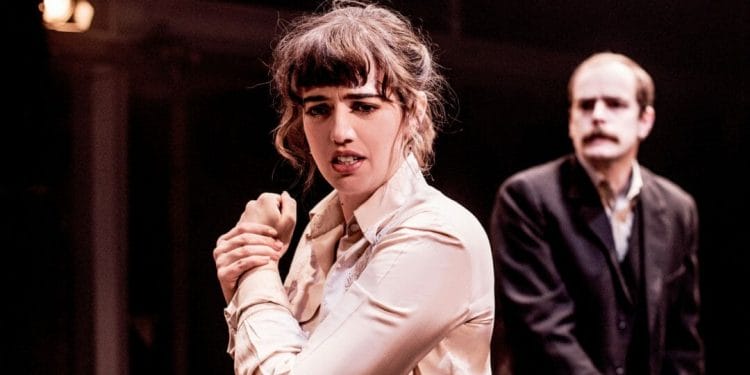 It was with some curiosity that I entered the Arcola Theatre to review this production of The Daughter-in-Law. Knowing D.H. Lawrence chiefly for invoking the passions and pains of early 20th century working-class life in newly industrialised Nottinghamshire in novels such as ‘Sons and Lovers’ and ‘Women in Love’, I was intrigued to find out how that world could be transferred to the stage.
It was with some curiosity that I entered the Arcola Theatre to review this production of The Daughter-in-Law. Knowing D.H. Lawrence chiefly for invoking the passions and pains of early 20th century working-class life in newly industrialised Nottinghamshire in novels such as ‘Sons and Lovers’ and ‘Women in Love’, I was intrigued to find out how that world could be transferred to the stage.
Lawrence described this first of his eight plays, completed in January 1913 as, “neither a tragedy nor a comedy – just ordinary” and it’s obvious that Director, Jack Gamble has worked hard to bring out elements of both here. The Daughter-in-Law covers familiar Lawrentian territory in this tale of the emotionally complex relationship between a mother, her two youngest sons and the wife of one of them, set against the backdrop of the miners’ strike of 1912.
It is as much a credit to the acting and direction as to the writing that the audience have so many opportunities to laugh as the doughty Mrs Gascoyne (Veronica Roberts) gives her sons, Luther (Matthew Barker) and Joe (Matthew Biddulph) the benefits of her worldly wisdom about life and love. The interaction between Mrs Gascoyne and the tightlipped Mrs Purdy, played by Tessa Bell-Briggs, similarly has a refreshingly light touch even in the delivery of an emotional bombshell which proves the catalyst for the course of the play. Ellie Nunn has to be praised for displaying the character of Minnie Gascoyne, the daughter-in-law of the title, through body language and movement as much as from some heartfelt dialogue. Biddulph, too, puts in a particularly strong non-verbal performance, allowing the audience to sense Joe’s feelings by just shifting his arm or raising his eyebrow. This demonstration of physical expression is useful as the play is delivered exclusively in a thick Nottinghamshire dialect. Without the non-verbal cues, a 21st century metropolitan audience may have struggled to understand what was going on in the action. Nevertheless, credit has to go to Dialect Coach, Penny Dyer for her part in helping to create an authentic setting.
That authentic setting is also evoked by the sepia toned lighting and simple set complete with blackened range and dresser which doubles as the interior of both Mrs Gascoyne’s humble abode and the more elegantly furnished first marital home of Luther and Minnie. The impression is of an image in a book on the history of the working class. The incessant clanking and shouting sounds of the coalmines between acts similarly remind us of the place of the play in history and in society.
With elements of high drama and emotion sitting alongside the comedy, The Daughter-in-Law proves to be an intense, engaging watch. With contemporary themes such as the premise of the interdependence of the personal and the political, class, money, gender equality, this production shows us that Lawrence’s foray into the theatre is anything but “ordinary”.






















